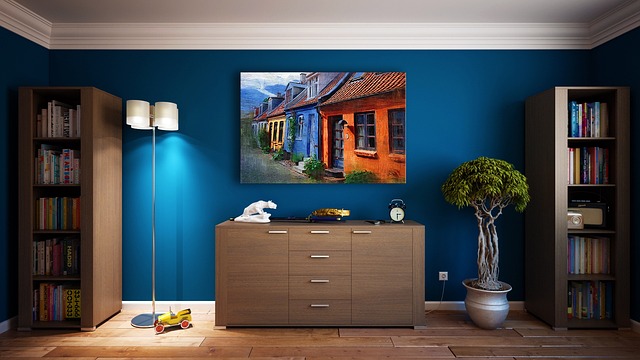Creating an environmentally friendly interior doesn’t have to be a challenge. With careful consideration and the right design choices, you can fashion a space that is both stylish and sustainable. Here, we explore some pivotal eco-friendly design concepts, materials, and practices that allow for living spaces that promote sustainability without sacrificing aesthetics. These ideas are not only crucial for the environment but also beneficial for our well-being.
Sustainable Design Concepts:
Biophilic Design
Biophilic design is a concept that connects the inhabitants with nature, creating a harmonious living environment that benefits both mental and physical health. It can be as simple as maximising natural light through well-placed windows or incorporating living plants into your home decor. By integrating elements such as wood, stone, and an earthy palette, a biophilic approach encourages a natural atmosphere within urban homes.
Other elements such as green walls or vertical gardens, natural fibre textiles and use of water features can significantly enhance the connection to nature. This design concept fosters a living space that not only breathes sustainability but also promotes a serene and rejuvenating atmosphere.
Upcycling
Upcycling reimagines waste materials or old items into fresh, functional designs. It nurtures creativity while reducing the carbon footprint associated with manufacturing and disposing of home furnishings. For instance, repurposing wooden crates into shelves or converting old glass jars into light fixtures can add unique charm and character to your home.
By incorporating upcycled pieces, you can give a second life to objects that might otherwise end up in landfill. It’s an act of creativity that speaks volumes about your commitment to sustainability and offers a one-of-a-kind aesthetic that mass-produced furniture simply cannot match.
Energy-Efficient Lighting
Energy-efficient lighting is an easy yet impactful way to make your home more eco-friendly. LED bulbs and smart lighting systems can drastically reduce your energy consumption, lowering carbon emissions and household bills. Ambient lighting, task lighting and accent lighting options have all embraced energy efficiency without compromising on design or quality of light.
Investing in energy management systems, like timers or motion sensors, further optimises your energy use, ensuring that artificial light is only used when needed. A well-considered lighting plan not only saves energy—it can enhance the mood and feel of each room.
Eco-Friendly Materials and Practices:
Sustainable Wood
Sourcing wood from responsibly managed forests is key in protecting our planet’s forests. Look for certifications like FSC (Forest Stewardship Council) to ensure that your wooden furniture or flooring supports sustainable forestry practices. Sustainable wood options include bamboo, reclaimed timber, or wood from rapidly renewable species.
Incorporating these materials sustains the cycle of renewal and reduces the harmful impact of deforestation. From flooring to furniture, choosing sustainable wood is a step towards making a lasting positive environmental impact.
Recycled Glass
Recycled glass, with its unique aesthetic appeal, serves as both an eco-friendly and stylish material for interiors. Functioning as kitchen countertops, backsplashes, or decorative accents, recycled glass is a versatile and attractive alternative to new, often unsustainably sourced materials.
Beyond its beauty, using recycled glass significantly lowers the energy required to produce new glass, reducing your home’s ecological footprint. It’s also incredibly durable, making it a wise investment for any eco-conscious homeowner.
Low VOC Paints
The quality of your indoor air is fundamental to your health, making low VOC (Volatile Organic Compounds) paints an important choice in any eco-friendly home. Traditional paints release high levels of VOCs, which can cause health issues and environmental damage over time.
Low VOC paints minimise these emissions, safeguarding both your well-being and the planet. They come in a full spectrum of colours, ensuring that style does not need to be compromised for health and environmental responsibility.
If you’re in Guildford and looking to transform your living space into a work of art, consider enlisting the expertise of professional interior designers. These skilled professionals can help bring your design vision to life, whether you’re aiming for a modern, minimalist look or a cozy, rustic ambiance. By searching on Google using the keyword “interior designers Guildford” you can explore a variety of design firms and individual designers offering tailored services to suit your style preferences and budget.
In Conclusion
Adopting eco-friendly interior design is a profound way to contribute to a healthier planet, creating living spaces that nurture both the environment and our well-being. Biophilic design principles, upcycling, and energy-efficient lighting are smart, stylish concepts that can transform your interior. Similarly, incorporating materials like sustainable wood, recycled glass, and low VOC paints is a testament to the fact that sustainable practices can and should be a part of modern design schemes.
Sustainability in interior design is not just a trend; it’s a necessary evolution as we become more conscious of our environmental impact. By making informed choices, we can create interiors that are kind to the planet and our pockets while also being aesthetically pleasing and functionally superior. The power to shape a sustainable future lies in every decision we make, from the light bulbs we choose to the paints we apply on our walls. Each step towards sustainable living is a step towards a brighter, greener future for all.

